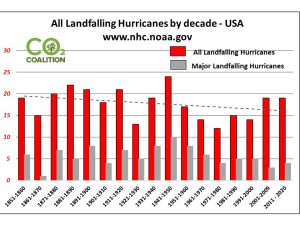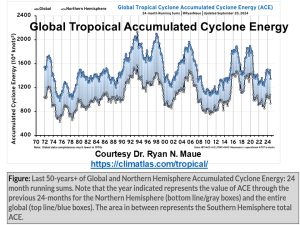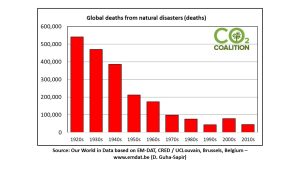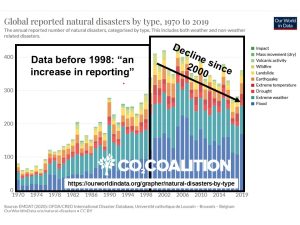Hurricanes and Floods and Twisters, Oh My!
by Gregory Wrightstone
As executive director of the CO2 Coalition, I quite often present the facts of a prospering planet and the lack of an increase in extreme weather. The Coalition sticks to the science, facts and data that show a slight decline in landfalling hurricanes, no increase in hurricane intensity and a significant decline in severe tornadoes (supporting charts below).
 You will be happy to learn that after experiencing two hurricanes and one tornado in less than two weeks, my skepticism about a dangerous connection between climate change and extreme weather remains fully intact. So, I won’t be calling for dumping trillions into the rathole of “green” energy to reduce atmospheric carbon dioxide.
You will be happy to learn that after experiencing two hurricanes and one tornado in less than two weeks, my skepticism about a dangerous connection between climate change and extreme weather remains fully intact. So, I won’t be calling for dumping trillions into the rathole of “green” energy to reduce atmospheric carbon dioxide.
A Pennsylvania native, I, along with my wife, recently settled near Tampa on the west coast of Florida at a location 10 feet above sea level — about 1,200 feet lower than a former home near Pittsburgh where residents are more accustomed to frost warnings than forecasts of winds exceeding turnpike speeds.
The Sunshine State greeted us in a matter of months with two hurricanes in quick succession, Helene and Milton. Both left us largely unscathed but mostly by chance.
In the first instance (Helene), our house was spared as others a few miles away were destroyed by flood waters. Our CO2 Coalition bookkeeper and her husband lost virtually everything but their lives.
In the case of Milton, our home was squarely in the crosshairs of most models. As it was a Category 5 hurricane at the time, we made the same decision as millions of others in the area and evacuated ahead of landfall. Contrary to most evacuees who headed north, we made what looked to be a perfectly reasonable choice to head southeast across the state to our friends’ condo at Vero Beach on the east coast.
 As it turned out, we evacuated to the most dangerous spot in Florida for this storm. During late afternoon and four hours before Milton made landfall, a particularly brutish storm cell developed that spawned dozens of tornadoes. One of them touched down along the iconic Highway A-1-A, and a building next to ours in the complex had windows blown out and parked cars destroyed. It could have been worse. For some, it was much worse.
As it turned out, we evacuated to the most dangerous spot in Florida for this storm. During late afternoon and four hours before Milton made landfall, a particularly brutish storm cell developed that spawned dozens of tornadoes. One of them touched down along the iconic Highway A-1-A, and a building next to ours in the complex had windows blown out and parked cars destroyed. It could have been worse. For some, it was much worse.
As fate would have it, I was doing a live video interview at the moment the twister struck, and I continued with howling winds, spectacular lightning and intermittent electricity causing the lights to flicker. In short, it was an epic interview.
The twister left a two-mile path of destruction that appeared apocalyptic when we ventured out the next morning.
We were very fortunate, as our home to the west was spared with no damage and electricity was remarkably restored in less than 72 hours after landfall. We are counting our blessings and looking to install a natural gas-fired home generator before the next hurricane season.



Gregory Wrightstone is a geologist; executive director of the CO2 Coalition, Arlington, VA.; and author of Inconvenient Facts: The Science That Al Gore Doesn’t Want You to Know as well as A Very Convenient Warming: How modest warming and more CO2 are benefiting humanity.
